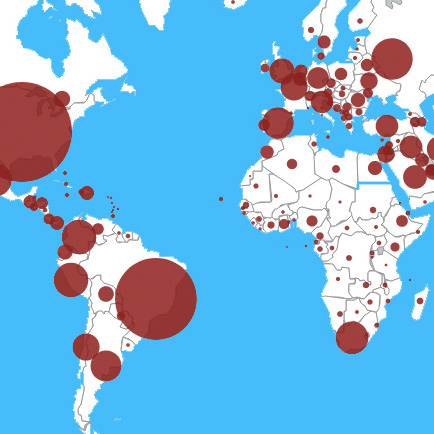COVID-19 in the United States and globally |  |
This is a new curriculum. We are refining the materials and teaching support according to teacher feedback. If you have any questions or comments, please use the contact form on the Get Help page and we will respond promptly. Thanks for your patience and understanding!
Lesson 0.1
How is SARS-CoV-2 impacting us here in the U.S.?
In this lesson, you’ll look at how Americans have been impacted by COVID-19, and delve into why we might be seeing such disparities in cases and deaths.
Lesson Objectives
By the end of the lesson, you will be able to…
- Explain the meaning of the various data points about COVID-19 such as cases, deaths, case-fatality ratio and deaths per 100,000.
- Navigate databases to look up and interpret data about the economic disparities among different demographics within the U.S.
- Make conclusions from the data about what may be causing COVID-19 disparities and understand the limitations of the conclusions.
0.11 The stories of COVID-19 (18 slides)
You’ll begin with a section that tells about the lives of some Americans who have died during this pandemic. Then you’ll share your own COVID story.
0.12 How are we doing today? (23 slides)
Now, you’ll put how the U.S. is faring during COVID-19 into the context of the world. You’ll get familiar with an important database that tracks COVID-19 cases and deaths worldwide.
0.13 COVID-19 in the U.S. (13 slides)
In this section, you’ll learn about U.S. demographics to answer the question – has COVID-19 affected us as we would have predicted?
0.14. Why are there such disparities in the U.S.? (23 slides)
Now you’re going to dig deep into the economic and social conditions that may have led to such deep disparities in how different communities have experienced COVID-19.
0.15 The Meat-Processing Plant (17 slides)
In this last section you’ll work through a case study that describes how working conditions can lead to specific vulnerabilities to COVID-19, and you’ll use the same databases to design your own case study about a vulnerability that’s of interest to you.
0.16 Apply your new knowledge!
Each lesson will end with a scientific or media article about the topic you have just covered. Now, you will be able to read the articles with a deeper understanding to evaluate their conclusions, and complete a reading worksheet.
The first article can be found here. It talks about how systemic racism has also contributed to COVID-19 disparities.
Documents
Section 0.14 table
Section 0.16 Reading worksheet
Lesson 0.2
How has COVID-19 impacted the world?
In this lesson, you’ll look at how different countries have dealt with the challenge of COVID-19. In particular, how has a country’s wealth impacted how it has handled the pandemic?
Lesson Objectives
By the end of the lesson, you will be able to…
- Explain the various factors that might influence how a country deals with a pandemic.
- Navigate databases to look up and interpret data about how COVID-19 has impacted various countries.
- Make conclusions from data about what may be causing COVID-19 disparities among different countries.
0.21 How has COVID-19 impacted other countries? (6 slides)
In this first section, you’ll go back to the Johns Hopkins database you used before to establish which countries have done best and which have done worst in responding to COVID-19.
0.22 What economic factors influence how a country responds to a pandemic? (24 slides)
For the next few sections, you’re going to be following how several countries have faced the challenge of COVID-19. In this section, you’ll use databases to establish the economic resources they had available, and then you’ll make predictions as to how they fared.
0.23 How well were countries prepared for a pandemic? (30 slides)
There is one more piece of information we need to understand global disparities – how well prepared each country was to deal with a pandemic. You’ll look at another database that ranked preparedness and then compare it with actual data on cases and deaths. How did the countries do?
0.24 Why are there global disparities? (19 slides)
Now you’re going to work with another set of data, this time from the United Nations to try to understand the role of health care capacity in countries’ responses to COVID-19. Where do the countries stand, and does their capacity fit in with their actual response?
0.25 Apply your new knowledge!
Read the news article found here that summarizes how all the pandemic simulation games carried out over the last few years failed to help the US manage COVID-19, and complete your reading worksheet.
Documents
Section 0.22 Global disparities worksheet
Section 0.25 Reading worksheet


